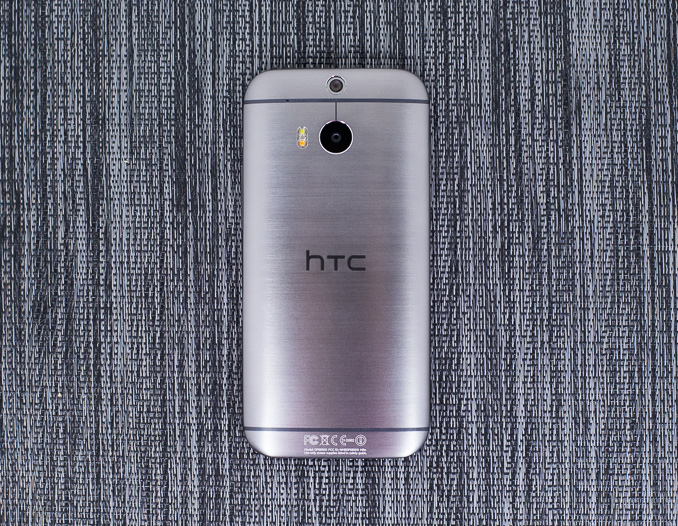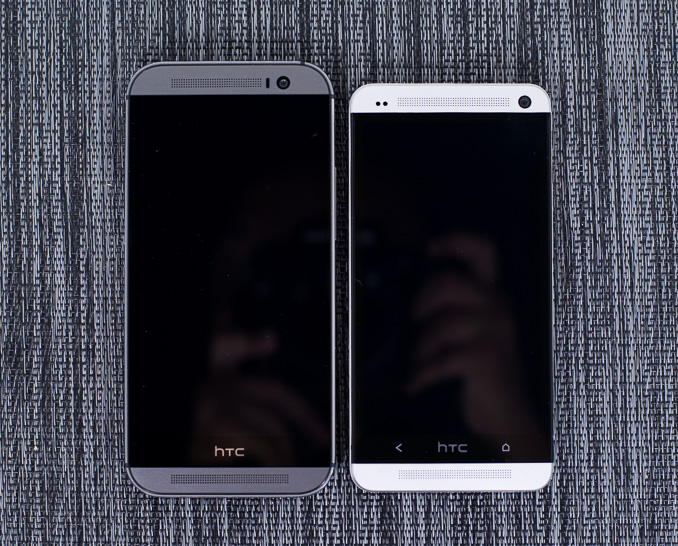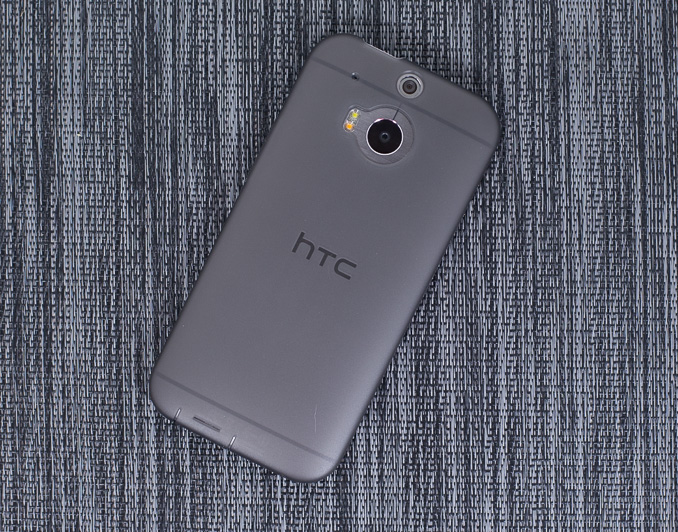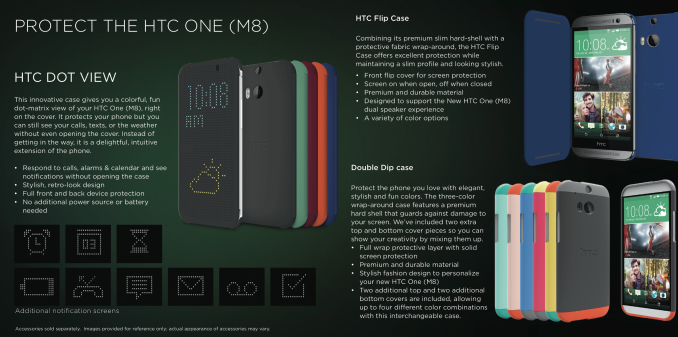The HTC One (M8) Review
by Anand Lal Shimpi & Joshua Ho on March 26, 2014 7:00 PM EST- Posted in
- Smartphones
- HTC
- Mobile
- HTC One

HTC remains one of few Android OEMs insanely focused on design. Even dating back to the origins of the One brand in 2012 with the One X and One S, HTC clearly saw design where others were more focused on cost optimization. Only time will tell which is the more viable long term business strategy, but in the interim we’ve seen two generations of well crafted devices from what would otherwise be thought of as a highly unlikely source. With its roots in the ODM/OEM space, HTC is one of very few ODM turned retail success stories that we’ve seen come out of Taiwan. ASUS is the closest and only real comparison I can make.
As its name implies, the goal of the One brand was to have a device that anyone, anywhere in the world could ask for and know they were getting an excellent experience. Although HTC sort of flubbed the original intent by introducing multiple derivatives (One X, One S, One X+), it was the beginning of relief from the sort of Android OEM spaghetti we saw not too long ago. With the One brand, HTC brought focus to its product line.
Last year HTC took a significant step towards evolving the brand into one true flagship device, aptly named the One. Once again there were derivatives (One mini and One max), but the messaging was far less confusing this time around. If you wanted small you got the mini, if you wanted big you got the max, otherwise all you needed to ask for was the One.
With last year’s One (codenamed M7), HTC was incredibly ambitious. Embracing a nearly all metal design and opting for a much lower resolution, but larger format rear camera sensor, the One was not only bold but quite costly to make. With the premium smartphone market dominated by Apple and Samsung, and the rest of the world headed to lower cost devices, it was a risky proposition. From a product standpoint, I’d consider the M7 One a success. A year ago I found myself calling it the best Android phone I’d ever used.
It didn’t take long for my obsession to shift to the Moto X, and then the Nexus 5, although neither delivered the overall camera experience of the One. Neither device came close to equaling HTC on the design front either, although I maintain Motorola did a great job with in hand feel. Although I found myself moving to newer devices since my time with the One last year, anytime I picked up the old M7 I was quickly reminded that HTC built a device unlike any other in the Android space. It just needed a refresh.
It’s been leaked beyond belief, but in case you haven’t seen it by now this is the M8, the new HTC One:
It’s taller and slightly wider than last year’s model (with a correspondingly larger 5” 1080p display), but all at roughly the same thickness. The all metal chassis is back, but with more metal. If you remove the display and internals, HTC claims the M8 chassis is now 90% metal compared to 70% with the M7. There is a weight impact, but the M8 never feels heavy at 160 grams.
The plastic ring around the M7 is gone, replaced with a single piece of aluminum that curves around the body. With the exception of a strip along the top edge, BoomSound speaker grills and some narrow strips on the back for antennas, the M8 is all metal.
The M8’s surface is a bit smoother than the M7, and there’s now a nice horizontal brushed effect in the gunmetal gray finish. The device is still every bit as wonderful to hold as its predecessor. The design is different, and overall I’d consider it better. For those who care about material feel and design it’s clearly a level above what you see on the market at this price point.
The device will be available in three different colors: Gunmetal Gray (what I was sampled), Glacial Silver and Amber Gold.
HTC also ditched the two fixed capacitive buttons, which was a pain point for some with the M7. Instead we have up to four on-screen buttons at the bottom of the display: back, home, multitasking, and menu as appropriate.
Appearances are meaningless if the device doesn’t have the hardware to back it up, and thankfully the M8 is an upgrade almost entirely across the board. I threw the relevant spec differences into the table below:
| HTC One (2013) | HTC One (M8) | |
| SoC | APQ8064AB 1.7 GHz Snapdragon 600 | MSM8974ABv3 2.3 GHz Snapdragon 801 |
| RAM/NAND | 2 GB LPDDR2, 32/64GB NAND | 2GB LPDDR3, 16/32GB NAND + microSD |
| Display | 4.7” SLCD3 1080p | 5” 1080p LCD |
| Network | 2G / 3G / 4G LTE (Qualcomm MDM9x15 UE Category 3 LTE) | 2G / 3G / 4G LTE (Qualcomm MDM9x25 UE Category 4 LTE) |
| Dimensions | 137.4 x 68.2 x 9.3mm max / 4mm min, 143 grams | 146.36 x 70.6 x 9.35mm max, 160 grams |
| Camera | 4.0 MP (2688 × 1520) Rear Facing with 2.0 µm pixels, 1/3" CMOS size, F/2.0, 28mm (35mm effective), 2.1 MP front facing | 4.0 MP (2688 × 1520) Rear Facing with 2.0 µm pixels, 1/3" CMOS size, F/2.0, 28mm (35mm effective) and rear depth camera, 5MP f/2.0 FFC |
| Battery | 2300 mAh (8.74 Whr) | 2600 mAh (9.88 Whr) |
| OS | Android 4.4 with Sense 5.5 | Android 4.4 with Sense 6 |
| Connectivity | 802.11a/b/g/n/ac + BT 4.0, USB2.0, GPS/GNSS, MHL, DLNA, NFC | 802.11a/b/g/n/ac + BT 4.0, USB2.0, GPS/GNSS, MHL, DLNA, NFC |
| SIM Size | MicroSIM | NanoSIM |
There’s a faster (and more power efficient SoC), a larger battery, and a higher resolution front facing camera. BoomSound gets a new amp and better sounding speakers, there's also a new dual color flash and a well integrated micro SD card slot (one that doesn't require a removable back). If you were pleased with last year’s One, chances are that you’ll be very happy with this one. If, however, you weren’t totally sold on the M7’s 4MP UltraPixel camera there’s a bit of bad news.
The story of last year’s One revolved around HTC’s decision to use a larger format 4MP camera sensor instead of moving to a higher megapixel sensor with smaller pixels. It was a polarizing tradeoff, but one that was somewhat validated by Apple with its choice of maintaining resolution but increasing pixel/sensor size with the 5s. The most obvious fix for those who had issues with the lack of spatial resolution with last year’s One would be to go to a higher resolution sensor, without going as far as Samsung and LG. Unfortunately, without the buying power of a company like Apple, HTC is left to pick from those sensors that are more widely available. In other words, options are limited.
The solution this round was to keep the rear sensor from the M7 (without OIS), and augment it with another rear facing camera module. I’ll get to the use of the second sensor in a bit, but ultimately that’s the going to be the biggest friction point with the new One. Those customers who were happy with the M7’s camera will be pleased this round, but those who wanted a slight bump in spatial resolution will be left wanting more.
Cellular Bands and What’s Launching
I’m aware of seven different M8 SKUs launching today. In the US, AT&T, T-Mobile, Sprint and Verizon are all getting the new HTC One. Verizon had immediate availability in stores 2 hours after launch, while AT&T and Sprint were available online the same day. All three operators should have devices by April 11th. T-Mobile is the exception as it won’t have the M8 in stores until next month.
Google will be taking preorders for the Google Play Edition of the new One today. Despite shipping with GPE Android, HTC claims the GPE M8 will support Duo Cam via HTC’s APIs (perhaps via a modified AOSP camera app?).
As far as I can tell only the AT&T and Google Play Edition SKUs support carrier aggregation. The two SKUs are quite similar from a cellular standpoint, with the AT&T model locking out UMTS band 4 to discourage movement to T-Mobile.
| HTC One (M8) Cellular Band Support | ||||||||
| FCC ID | Operator/Region Target | CDMA Bands | GSM | WCDMA | LTE | CA | ||
| NM80P6B100 | EMEA | - | 850, 900, 1800, 1900 | 850, 900, 1900, 2100 | 3, 7, 8, 20 | - | ||
| NM80P6B120 | AT&T | - | 850, 900, 1800, 1900 | 850, 1900, 2100 | 2, 4, 5, 7, 17 | 4+17, 2+17 | ||
| NM80P6B130 | T-Mobile | - | 850, 900, 1800, 1900 | 850, AWS, 1900, 2100 | 4, 17 | - | ||
| NM80P6B200 | Verizon | 800, 1900 | 850, 900, 1800, 1900 | 850, 900, 1900, 2100 | 4, 7, 13 | - | ||
| NM80P6B700 | Sprint | 800, 1900 | 850, 900, 1800, 1900 | 850, 1900, 2100 | 25, 26, 41 | - | ||
| NM80P6B160 | Canada | - | 850, 900, 1800, 1900 | 850, AWS, 1900, 2100 | 4, 7, 17 | - | ||
| NM80P6B170 | Google Play Edition | - | 850, 900, 1800, 1900 | 850, AWS, 1900, 2100 | 2, 4, 5, 7, 17 | 4+17, 2+17 | ||
With the exception of the Sprint SKU, all of the remaining M8 SKUs feature Qualcomm’s QFE11xx envelop power tracker. In addition, all SKUs with the exception of the T-Mobile and Sprint devices use Qualcomm’s QFE15xx antenna matching tuner. None of the M8s use the CMOS power amps and it’s still too early for the rest of Qualcomm’s RF360 platform. Unfortunately this present refresh comes a little too early for Qualcomm’s next-generation Category 6 LTE 9x35 modem.
Launching with immediate availability in the US and UK, with other regions following in the coming weeks, is an incredibly difficult feat to pull off. It also helps explain why there were so many leaks leading up to today’s launch. The real trick is timing launch availability and sampling so you don’t have operator partners spoiling your launch, but that’s a challenge for another day.
Inside the One’s box you’ll find the usual suspects: earbuds, USB cable and charger. New this round is you’ll find a simple case in your box. The included case is a no frills design, but it’s awesome to find something like that in the box these days.
HTC will gladly sell you one of their Double Dip, Flip or new Dot View cases. The former now includes two sets of top/bottom colors with each case. The Dot View case is interesting as it enables some glance usage models, but without an AMOLED display I’m curious about the power impact.





















222 Comments
View All Comments
jonup - Friday, March 28, 2014 - link
My point exactly! I was not arguing that the One has the best or better camera than the other flagships. All I said is that people a bashing the phone over a camera that is good enough (ok if you wish) in the day light but it (the phone) is exceptional in any other way (save for the wasted real estate by the logo). I would give up 600mah of battery to get rid of the black stripe underneath the display. Which brings me to the other Samsung sponsored reviewers argument - on screen keys vs capacitive key. On-screen keys is the Google way. Not the iOS Samsung copy cat way. I wish there is more custom-ability in the GEL and in the OEM laucher to set height of the nav bar, the width of the buttons, and the choice of buttons. As usual my two cents.mkozakewich - Sunday, March 30, 2014 - link
It doesn't take steady video, which is where it's more important. All the regular photos in this article were still shots, except for the video demonstrating the difference between the M7 and the M8.sephirotic - Sunday, March 30, 2014 - link
4k recording is worse than gimmick on any 1/3" sensor. Compression efficiency on smartphones is very low and unoptimized for video, there is simply no way to retain actual 1080p motion resolution with currect processors and pixel pitch of 1/3 sensors. Z2 samples makes this obvious, Actual true resolution on Z2 is worse than a semi-professional 720p video on a 2010's GH1. I'd rather have a more efficient 1080p compression and slow motion than 4k. EVEN IF there was actualy improvement from 1080p videos on 4k recorded from smartphone, 99% of regular costumers woudn´t even have a 4k screen to display it. Using for mastering casual videos? Even less likely.4k video on smartphone is just plain idiotic.
However I do agree 4mp is a little on the low side even for 1/3" sensor but no doubt pushing anything beyond 8mp is pure gimmick. it's a shame that sony kept pushing the megapixel race for so long even after the other manufactures stoped with this nonsense and now this is back on Smartphones and Video.
I do agree removing OIS is sad drawback.
CoryWeston101 - Monday, March 31, 2014 - link
Let's get some facts straight. NO ONE NEEDS 4K recording on a smartphone or period. Less than 1 percent of the poulation has 4K TVS or monitors making 4K recording a useless gimmick. You need it that badly go by an actually 4K camera from Sony or Cannon or someone. It will do a better job. But 4K recording is a stupid useless gimmickThey took OIS out because of the 2 camera set up. And also with a 2 camera set up YOU DON'T NEED OIS as it essentially does the same thing only better. The camera is a giant leap forward And no that's not why it is getting knocked. It is getting knocked because of the uneducated people out their like.
You bring the Moto X up? The Moto X camera sucks. The M8 camera makes the X camera look like a childs toy.
The M8 has one of the best cameras on a smartphone. They did not regress. They progressed. You are just to daft to understand.
CalaverasGrande - Monday, March 31, 2014 - link
4k recording on your smartphone?What phone DOES do that now.
Anand R - Tuesday, April 1, 2014 - link
You want 4K recording? What for? Do you have a 4K screen? Besides, even if you do, why not use an actual camera for 4K recording (which would be better in every way) rather than use a phone camera?purerice - Saturday, April 12, 2014 - link
Complaining about lack of recording 4K... on a cellphone... with 16GB total storage...Please tell me you forgot the "/sarcasm" tag.
Few cell phone cameras can compare to even a low end PaS camera in good light. Reduce the light level, increase the distance, add some motion, and the point&shoot wins by leaps and bounds. Olympus and Panasonic make decent all-weather cameras that fit in your pocket for 1/2 the price of a flagship cellphone.
If the phone has a good enough camera for video calling and quick snaps, it's good enough for me. I would no more replace a real camera with a cellphone because the cellphone can remedially take photos, than I would replace a computer with a cellphone because my cellphone can remedially edit spreadsheets.
doosh bag - Thursday, March 27, 2014 - link
I totally agree. The camera is more than capable enough in the opinion of professional photographers, but these nudniks out here, these spec snobs can't seem to find anything better to do than regurgitate the same tired, flimsy rhetoric, they read from some meshuggah reviewer, again and again. Far as I can gather from the comments on this first page, none of these yentas even own a M7 or a M8. It's all third person narrative. I own the M7 and let me tell you something, that camera is boss. For example, I was driving down the interstate in the desert, around 70 mph, driving into a beautiful sunset. I held the phone up to the side window and held the shutter button for a few seconds. Got about 20 shots. In one shot there was a semi truck going by, in the opposite direction, in the farthest lane away from me, traveling roughly the same speed, about 200 feet away, in failing light. So, combined speed between the two of us, about 130 mph. I snapped these photos in portrait mode. The picture looked as if everything were perfectly still. The detail so sharp that, without zooming the photo at all or flipping it to landscape view, I can clearly see and count all the lug nuts on the front wheel of that truck. There is nothing wrong with that camera. That camera does everything it's supposed to do and it does it exceptionally well. It's every bit as good as most, and almost as good as some. Comparison after comparison has proven it to be more than adequate. Someone mentioned 4K recording. Let me explain something to you people. 4K is a gimmick. It's a joke. 4K went be commercially viable for another 5 years, if then. They don't even have proper codecs to deal with it. Still using HD codecs to render Ultra HD source code. No phone can render the 4K video it shoots. Televisions and monitors are extremely expensive.puremind - Saturday, March 29, 2014 - link
I also totally agree. The M7 convinced me more in terms of shooting clean blur free, fast focused pictures. Other phones have let me down big time. MP give you sharper pictures if you are lucky... That's 30% of the time. I have regretted not being able to crop but I liked thetrade off of faster shooting.Death666Angel - Friday, March 28, 2014 - link
"If you are into photography that you care so much about picture detail, you won't be using you phone to take pictures."That is such a stupid argument. Considering that smartphones are alround devices capable of many things, you can say that just about every feature;
- if you care about high speed browsing, you will use a laptop/desktop
- if you care about listening to music, you will use headphones/DAC/dedicated mobile players
- if you care about video chat, you will use a 4k camera and a high end beamer
That do a lot and thus nothing really spectacularly. But that's not the point here, is it?